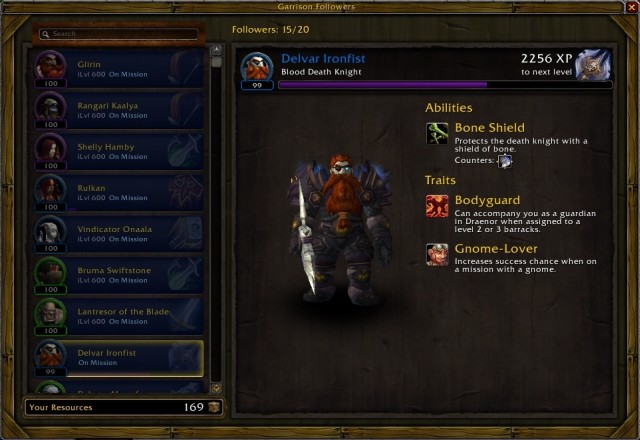WoW Warlords of Draenor: The system of followers
The most recent expansion to the World of Warcraft introduces dozens of heroes into the game, who can be recruited. These are AI-controlled characters but, to a limited extend, you can issue orders. Each one has a name, a backstory, race, class, and special abilities. The majority of the followers progress in experience, just like you do, they may be at levels between 90 and 100, i.e. it is the same as in your case. They also gain experience by completing missions and, as soon as they gain enough of it, they progress to the next level. With time, they can also obtain new abilities, which come in handy during missions, and which make them more versatile. After a follower reaches level 100, you can give him gear that bolsters his power even more.

It is worthwhile to have a closer look at the abilities of your followers. The most important category is "abilities". We will take a closer look at "Traits" later on.
The abilities determine which attacks can be countered by your follower, which is tightly connected with the missions that you dispatch him on. It is a good idea to focus now on what the missions look like. Each mission is to dispatch between one and three followers against one, or several opponents. Each of the opponents has one, or several, special abilities, e.g. Danger zones. What you need to do is dispatch the follower that has the ability to counter such attacks. Usually, one attack can be countered by several different abilities of your followers. In the case of the Danger Zones, the ones in question are e.g. Sprint or Heroic Leap. Fortunately, in the followers selection menu, you learn which of the characters have the required ability. Things get much more difficult later into the game, when you, e.g. want to complete 8 missions, but you do not know how to distribute the followers, to tip the scales over to your side.

The situation is even more complex, if you want to learn about the traits of your followers. To make things easier, I have put them into three categories:
The first one is the divisions into the followers with and without the Bodyguard ability. What does make it so important? It determines if a follower can accompany you, while completing the quests in Draenor, i.e. if they can aid you in combat. To use this ability, you first need to upgrade the Barracks to tier two. The function of the follower, in the party, may vary, depending on his class. He may be a tank, a healer or an assault. In each of the cases, however, he is much needed help.
The second group are the traits connected with professions. Some of your followers may have abilities such as Blacksmithing, Tailoring or any other, directly connected with a profession. Such followers can be assigned to individual buildings, whose main functions are connected with that profession. You receive the option to assign a follower to a building after you upgrade that building to tier two. If, e.g. one of your followers has Mining, you can assign him to the garrison mine, which additionally profits you. You need to remember though that the assigned followers cannot be dispatched on missions.
The third group of traits are the ones connected with profits to mission success. Thanks to some of them, your follower is more proficient at killing a specific type of enemies. Thanks to other traits, you receive a bonus after you dispatch the follower on a jungle mission, whereas there is a completely other trait to determine interracial relations. If you dispatch, on a mission, a dwarf with the Gnome-Lover trait, and a Gnome you receive an increased chance of the mission's success. In truth, however, such traits and factors are so plentiful that they are, probably, impossible to grasp. Additionally, their effect on the chance of success of the mission is so low that waste a dozen-or-so minutes to assemble the entire party.
- World of Warcraft: Warlords of Draenor Game Guide
- WoW Warlords of Draenor: Detailed guide
- WoW Warlords of Draenor: Detailed guide to WOW Warlords of Draenor
- WoW Warlords of Draenor: Markings in this guide
- WoW Warlords of Draenor: The garrison
- WoW Warlords of Draenor: The purpose and functions of the garrison
- WoW Warlords of Draenor: Garrison management
- WoW Warlords of Draenor: The suggested order to expand your garrison
- WoW Warlords of Draenor: How to obtain new resources
- WoW Warlords of Draenor: Buildings (big)
- WoW Warlords of Draenor: Buildings (medium)
- WoW Warlords of Draenor: Buildings (small)
- WoW Warlords of Draenor: Miscellaneous buildings
- WoW Warlords of Draenor: Outposts
- WoW Warlords of Draenor: The system of followers
- WoW Warlords of Draenor: Picking and dispatching followers on missions
- WoW Warlords of Draenor: Recruiting new allies
- WoW Warlords of Draenor: Dungeons
- WoW Warlords of Draenor: Bloodmaul Slag Mines
- WoW Warlords of Draenor: Iron Docks
- WoW Warlords of Draenor: Auchindoun
- WoW Warlords of Draenor: Skyreach
- WoW Warlords of Draenor: Grimrail Depot
- WoW Warlords of Draenor: Shadowmoon Burial Grounds
- WoW Warlords of Draenor: The Everbloom
- WoW Warlords of Draenor: Upper Blackrock Spire
- WoW Warlords of Draenor: Mounts
- WoW Warlords of Draenor: Achievement-related mounts
- WoW Warlords of Draenor: Garrison-related mounts
- WoW Warlords of Draenor: Profession-related mounts
- WoW Warlords of Draenor: Reputation-related mounts
- WoW Warlords of Draenor: Mounts that you obtain after you defeat an opponent
- WoW Warlords of Draenor: Mounts that you obtain from PvP duels
- WoW Warlords of Draenor: Remaining mounts
- WoW Warlords of Draenor: Fieldcane Add-ons
- WoW Warlords of Draenor: Curse
- WoW Warlords of Draenor: Garrison Mission Manager + Master Plan
- WoW Warlords of Draenor: HandyNotes
- WoW Warlords of Draenor: Bagnon
- WoW Warlords of Draenor: System requirements
- WoW Warlords of Draenor: Detailed guide
You are not permitted to copy any image, text or info from this page. This site is not associated with and/or endorsed by the developers and the publishers. All logos and images are copyrighted by their respective owners.
Copyright © 2000 - 2025 Webedia Polska SA for gamepressure.com, unofficial game guides, walkthroughs, secrets, game tips, maps & strategies for top games.
